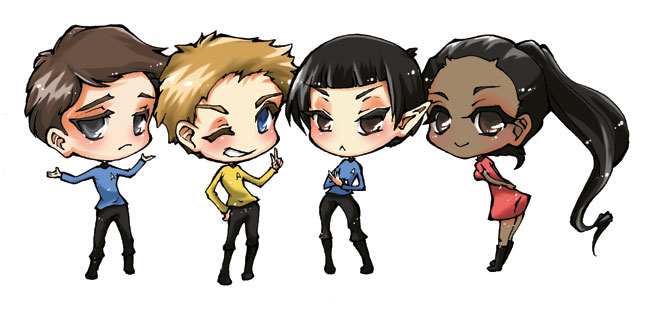
April 29, 2010
Star Trek Fandom
The Japanese trekkie community is expanding at warp speed
By Metropolis
Originally published on metropolis.co.jp on April 2010
“Chouju to han’ei wo.” Or, as some of us are more used to hearing, “Live long and prosper.” Those iconic words, first spoken by Mr. Spock in the original Star Trek television series some 40 years ago, helped usher in a new era of science fiction television across the world. And Japan was no exception.
While the world of Japanese Star Trek fandom is not as readily visible as, say, goth loli or the cult of Pikachu, trekkies are lurking around nearly every corner. In particular, the series (known in Japan as Uchu Daisakusen) has had a strong influence on men now in their 30s and 40s.
“Nearly everyone watched it at least once growing up,” says Tenjin Hidetaka, 36, a mechanical designer for the popular Macross Frontier anime series. “Fans told me about Star Trek: The Next Generation, which at the time was being serialized…. From the moment I tuned in, I was hooked. It was the first time that I became completely involved in a television show.”
Star Trek debuted on Japanese TV in the ’70s, and the first unofficial fanclub, Starfleet Kyoto, formed soon after. A few years later, the fan base grew when the Japanese edition of popular sci-fi magazine Starlog began publishing special issues with interviews and behind-the-scenes photos. In 1980, an 8-bit text-based simulation game based on the series became the country’s top-selling title shortly after its debut. More new fans were beamed aboard in 1992, when The Next Generation began its long-running serialization, and then again when small publisher Japan Mix released a series of Star Trek-related fiction and guidebooks a few years later.
The series has proved enormously influential in pop culture as well. Leading game show America Oudan Ultra Quiz, which ran on Nippon TV from 1977 to 1992, used a version of the original Star Trek music as its opening theme, and the 2005 film Summer Time Machine Blues featured a character who dressed up as Commander Riker from The Next Generation. Perhaps the best-known tribute came from superstar band M-Flo, who rewrote the original Star Trek theme to coincide with the series’ 40th anniversary. Titled “Love Long and Prosper,” the track is available on the album electriCOLOR.
Although Star Trek fever broke with the cancellation of spin-off series like Voyager and Deep Space Nine, interest is heating up again thanks to last year’s big-screen release. At the December edition of Comiket, the bi-annual doujinshi event that draws tens of thousands of people to Tokyo Big Sight, visitors could find almost any type of fan-generated material imaginable. The series’ appeal to Japanese anime and manga devotees is obvious—the episodes are by turns humorous, adventuresome, romantic and yaoi.
In the pre-internet days, small-scale Star Trek clubs like Uchu Ringo, which hosted gatherings and parties for fellow fans, were the norm. Nowadays, most fans have moved to Mixi as a central rallying point, with the largest trekkie community boasting nearly 7,000 members. The Japanese version of Memory Alpha, the Star Trek wiki, hosts nearly 2,000 articles.
All of this activity has boldly led to where no Japanese has gone before: an official Japan-based Star Trek fan club, which debuted in February. Featuring members-only events and original merchandise, Starfleet Far East is the culmination of 40 years of fandom. For Japan’s keitai legions, there’s also a cellphone site where, for a monthly fee of ¥350, users can access ringtones, sound effects, animated screensavers and the latest Star Trek news.
Official fanclub: www.1701.jp. Keitai site: http://web.peex.jp/startrek/.








